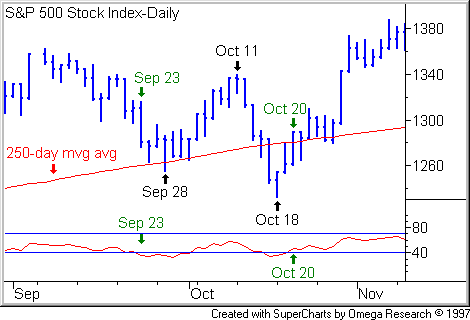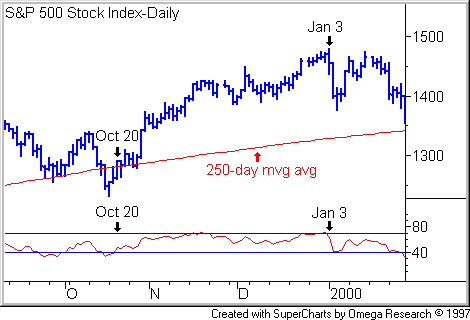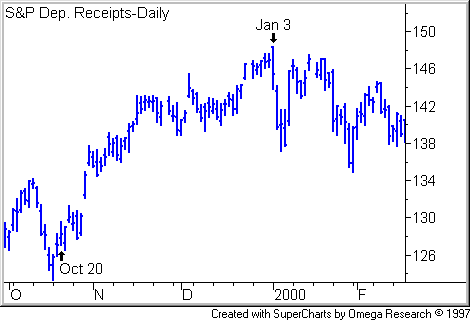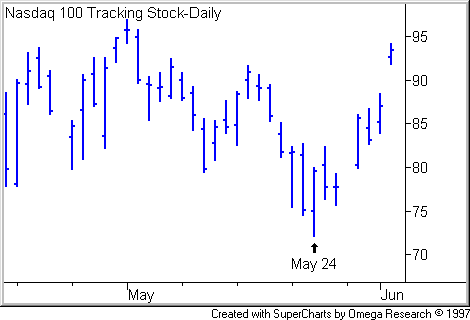Today’s Trading Lesson From TradingMarkets
Editor’s Note:
Each nweekend we feature a different lesson from
TM University. I hope you enjoy and profit from these.
E-mail me if you have
any questions.
Brice
ETF Trading
Tactics, Part 2: How To Use RSI To Trade Index Funds
By Loren Fleckenstein
Index shares,
exchange-traded funds that track stock indexes,
form a relatively new class of security. But as fund
traders, we can borrow time-tested tactics used by futures pros who have
traded off the same indexes for years.
A case in point is the
Relative Strength Index. Futures traders have
used the RSI to detect overbought and
oversold levels in the S&P 500 ($SPX.X)
and Nasdaq 100 ($NDX.X)
stock indexes as well as a wide variety of other markets.
In this lesson, I’ll teach you how to
use the RSI to time buys of the Standard & Poor’s Depository Receipts (SPY)
and the Nasdaq 100 Tracking Stock (QQQ).
These
exchange-traded funds, commonly called Spiders
and Cubes, track the S&P 500 and Nasdaq 100,
respectively.
About the RSI
The RSI is a momentum oscillator
developed by J. Welles Wilder Jr. and first publicized in 1978. It measures
day-to-day up and down closes in an index or security over a given period.
The oscillator’s readings range from 0
to 100. Extreme low readings indicate an oversold condition. Extreme high
readings flag an overbought condition. The system discussed in this tutorial
uses RSI only as an entry signal. So we will concern ourselves only with
oversold levels.
Don’t confuse RSI with
relative strength. The RSI measures an index
or security’s performance against itself. Relative strength compares a
security’s performance to an external benchmark, such as a stock index or a set
of other individual securities.
Using the RSI to
Trade Index Shares
When an index or security enters a
strong trend, it will stay in overbought or oversold territory on the RSI for a
long time. Just buying or selling index shares when their underlying stock index
hits oscillator extremes will land you in the poor house.
For instance, if you bought and held
Spiders whenever the RSI flashed oversold, you eventually would end up riding a
correction or bear market right into the tank! So if you use the RSI, you need
additional signals identify possible market turns.
I’m going to show you a way to use the
Relative Strength Index in combination with other
variables to spot bottom reversals on the S&P 500 and Nasdaq 100. In
a nutshell, we want to see the RSI enter an oversold condition, then re-emerge
to the upside. Meanwhile, the stock index itself must confirm the rally by
trading above a long-term moving average.
This bottom reversal signal was
introduced to me by Jay Kaeppel, director of research at Wheaton, Ill.-based
Essex Trading Co., and author of two primers on options and futures trading:
The Four Biggest Mistakes in Futures Trading and The Four Biggest
Mistakes in Option Trading (Traders Library).
Kaeppel uses this tactic to trade
options on the OEX, but he has found that the same approach works well for
trading the Spiders and Cubes.
The system has a good record of
alerting traders to intermediate-term rallies. But of course, not every signal
will lead to a rally. Some upturns will fail.
You must combine any trading system
with money-management controls — chiefly, position sizing and protective stops
— to safeguard your account from severe losses and to take profits. You’ll also
rely on your own trailing stops or sell rules to furnish your exit strategy, as
we’ll be using the RSI signal solely as an entry mechanism for exchange-traded
funds.
Configuring Your
Charting Software
We will watch stock index itself for
signals, rather than the trading action of the exchange-traded fund that you
plan to trade.
To use this system, you’ll need
charting software that includes the RSI and moving averages and allows you to
configure those indicators at will.
Set the RSI’s oversold boundary (buy
zone) at 40 and the length to
14 days. If your software makes you to enter
an overbought boundary (sell zone), choose an arbitrary number above 40. It’s of
no importance because, as I said, this is strictly an entry mechanism. I
selected 70. Also set a 250-day simple
moving average on the targeted stock index.
Entry Rules
1. The stock index falls, sending its
RSI below 40, but the stock index still closes above its 250-day moving average.
This alerts you to potential bottoming action.
2. Next, the stock index rallies, then
declines again. In this decline, the stock index can hold above the prior low or
make a new low. It can remain above the 250-day moving average or cross below
it. But the RSI must drop below 40.
3. Buy if the stock index rallies far
enough to lift the RSI above 40 and the stock index stands above its 250-day
moving average.
S&P 500 and Spiders
Let’s look at an example of how you
would buy S&P 500 Depository Receipts (SPY),
using the RSI of the S&P 500 ($SPX.X).

On Sept. 23, 1999, the S&P 500 fell
29.75 points to 1280.75. The 14-day RSI slipped to 34.99 from a reading of 42.07
in the prior session. The index was trading above the 250-day moving average.
That satisfied Rule 1. You got your
wakeup call! Now you want the index to rally and fail.
The index obliged. After marking a
session low of 1256.30 on Sept. 28, the S&P climbed to a session high of 1339.25
on Oct. 11. The RSI climbed back above 40. Then the stock index rolled over,
making a new intraday low of 1233.65 on Oct. 18. The RSI slid below 40 in the
prior session. Rule 2 is met.
Now the hammer is cocked. It remains
for the index to rally sufficiently to pull the trigger. That means the index
must advance far enough to overcome its 250-day moving average and lift the RSI
back above 40.
The S&P rallied off the Oct. 18 low.
It closed up to 1289.45 on Oct. 20, clearing both bogeys on the RSI and moving
average. Check off Rule 3. At this point, you would have gone long the Spiders,
establishing your initial and trailing stops and position size in accordance
with your money management regime.
Here are longer-term views of the
subsequent market action in index and Spiders from the same setup and entry.


Nasdaq 100 and
Cubes
The Nasdaq 100 ($NDX.X),
which tracks the 100 largest-cap non-financial stocks traded on the Nasdaq,
flashed a buy signal on May 24, 2000. At that point, you would have gone long
the Nasdaq 100 Tracking Stock (QQQ).

As you can see from the chart, the
stock index dropped 200 points to 3245 on May 10, decreasing the RSI to 37.04
from a reading of 41.34 in the previous session. At the time, the index remained
above its 250-day moving average.
The stock index subsequently rallied
to a May 16 peak, then headed south, carrying the RSI back below 40. The stock
index made a new low on May 24, then rebounded the same day, clearing its
250-day. The oscillator registered 40.15, just barely in the buy zone but enough
to flash your buy signal.
Here’s a chart of the Cubes over the
same time frame.

Â
Part 2 in a series
of three. Also see
Part 1: Identify ETF Turns Using Moving Average Crossovers, and
Part 3: How to Short ETF Breakout Failures.
